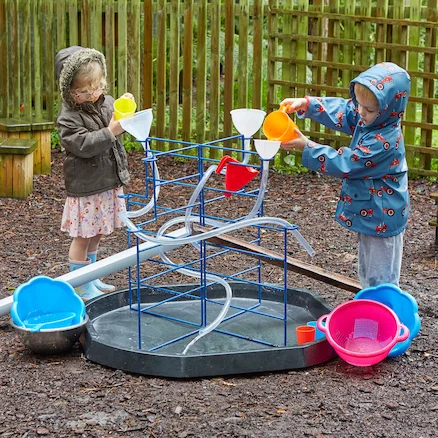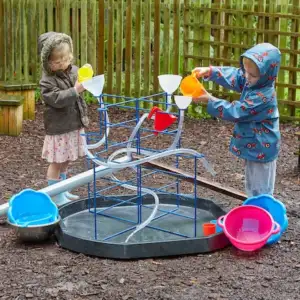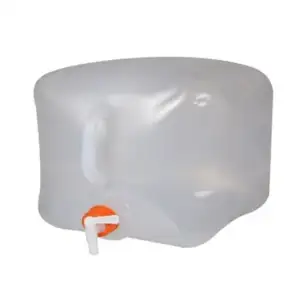Alistair Bryce-Clegg dives into the topic of common play behaviours & skill progression when it comes to the water play area.
For young children, few activities spark as much wonder, sensory exploration and blissful engagement as free play with water. The water table’s constantly shifting, flowing liquid canvas offers an irresistible invitation to investigate, experiment and indulge their boundless curiosities. And within this dynamic play arena, a remarkable spectrum of skills are being developed across cognitive, physical, social and emotional domains.
In order to ensure that we are providing children opportunities for learning and progression in the areas of provision that we create, I find it really useful to identify what I refer to as ‘common play behaviours’ and ensure that our provision is full of resources and opportunities to support and extend them.
What are ‘Common Play Behaviours’:
Common Play Behaviours are the natural, frequently observed patterns of exploration, investigation and expression that children engage in spontaneously through self-directed, open-ended play experiences. These behaviours serve as visible indicators of the underlying cognitive, physical, social, and emotional skills children are organically developing.
Let’s dive into (do you see what I did there?!) some of the most prevalent play behaviours you’ll observe in water provision, along with the skills and competencies that children are acquiring and rehearsing in the process:

Exploring Properties Through Sensory Immersion
One of the first tendencies you may notice is children’s innate drive to fully immerse themselves in the sensory experience – plunging their hands deep, pouring and scooping with ‘enthusiasm’, even dousing their entire bodies – if permitted! Through this physical and cognitive engagement, they construct vital understandings about:
- How fluid behaves like flow, movement, and buoyancy
- The early exploration of concepts like capacity
- Cause/effect patterns of action and reaction
- Transformation states as water takes different forms - like ice
- Properties like temperature, viscosity and density
‘Viscosity’ is the thickness a liquid. In water play, children can explore and experience it by adding different substances to change the water’s viscosity. For example, adding soap or corn flour makes the water more viscous and thicker. Observing and manipulating the varying viscosities allows children to build an understanding of a fluid’s property through hands-on sensory experiences.
Engaging in Symbolic Representation
As children manipulate water and loose parts, you’ll inevitably witness examples of symbolic representation and storytelling taking shape. A simple setup of cups, bowls and tubes may provoke river imaginings, pounding the surface represents a storm, blobs of soap become animal characters, and so on.
This progression from sensory to symbolic/abstract thinking reflects a pivotal cognitive leap. Children assign new meanings to common objects, recreate scenes from their experiences, and encode narratives through their actions – building critical language, literacy and perspective-taking skills.
Make sure your water provision has some familiar and some ambiguous resources to allow for storytelling and imagination.

Cooperation and Joint Effort
The size of your water provision indoors and out should allow for collaborative efforts and social negotiation. On the whole, children love water play – the bigger you can make the space the better. If you struggle for space, you can stand your water tray inside a much larger builders tray or tuff tray and get children working on multiple levels. You may need a mop!
Ideally children will be able to rehearse:
- Dividing roles and combining their efforts toward larger pursuits
- Coordinating the flow and direction of water
- Negotiating over usage of limited materials
- Navigating conflicts when play scenarios become disrupted
These types of interactions cultivate invaluable social-emotional competencies like communication, compromise, emotion regulation and an appreciation for differing perspectives. As children work in parallel and build onto one another’s ideas, they practice the foundations of teamwork, empathy and belonging.
The secret to this sort of interaction is to have a variety of materials and a large enough space. It is difficult to develop skills like this if your water provision is just jugs and funnels!
Demonstrating Persistence, Drive and Resilience
Our areas of provision should allow authentic “productive struggle” and opportunities to practice resilience, as well as support. Children’s water play pursuits may encounter frequent disruptions:
In your provision can they:
- Stem the movement or flow of water? Constructing dams and channels? (try adding in some guttering or piping)
- Submerge loose parts and experience cause and effect through buoyancy? (like a ping pong ball)
- Reroute water or transfer it over levels? (try adding a container with a tap, turkey basters and aquarium tubing)
Rather than becoming hopelessly frustrated, you’ll observe children rising to meet these challenges through persistent effort and new strategies. Their intense drive to engage in water play tend to produce a focus to achieve their vision and helps them to rehearse the management of their emotional self-regulation.
Exercising Creativity and Innovation
Another dimension of water play is its inherent propensity for creative, divergent thinking and innovation. With no prescribed ‘activity’ or end goal, the open-ended nature invites children to repurpose common objects as tools, devise original techniques, and work inventively with what they have got.
You may see cups used as funnels, paper towels used to divert flows, turkey basters or dropper bottles implemented as measurement devices, or any number of resourceful, unconventional approaches limited only by a child’s ingenuity and willingness to experiment. This unstructured experimentation process nurtures creativity, critical thinking and productive risk-taking.

Refining Motor Skills Through Water Play
Finally, the water area provides a highly engaging context for developing strength, dexterity and refinement of both gross and fine motor
Activities like:
- Pouring, scooping, squeezing and pumping actions
- Manipulating tools like whisks, tongs, basters and more
- Balancing, constructing and building to create water structures
- Core engagement from experimenting with the movement of water at different levels
…all work to integrate bilateral coordination, hand-eye tracking, isolated hand movements, body control and crossing the midline – prerequisites for everything from writing to playing a musical instrument!
By intentionally observing children’s common play behaviours and enhancing your water play spaces with loose parts, interesting tools and open-ended provocations, you create an ever-evolving platform for exploration and focused engagement.
I say, embrace the joyful mess – and make sure you have a mop or two within reach!
Alistair Recommends
Dr Alistair Bryce-Clegg suggests related resources to help you in your own setting. All available on the TTS website.
Get your Free CPD Training
We hope this blog has been handy for adding some useful tips into your practice. Want to learn even more? We invite you to explore our free CPD training hub. We offer a range of courses designed to help boost your skills. Take a look for yourself and see how you can improve your practice today!




